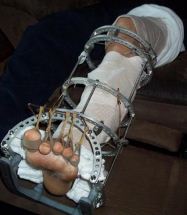A firefighter in Indiana suffered a full cardiac arrest while taking the Work Capacity Test, or Pack Test, in March. Thankfully, as a result of the precautions that were in place, including the presence of an Automatic External Defibrillator (AED), there was a positive outcome.
Here is the text of an After Action Review.
===============================================================
March 6, 2012
This AAR was prepared for Drew C. Daily, State Fire Coordinator for the Indiana Department of Natural Resources, Division of Forestry, Fire Control Headquarters by Stephen W. Creech (State Fire Coordinator Retired). Drew is serving as the Operations Section Chief for the Department of Homeland Security following the tornado events that took place on Friday, March 2, 2012. I was present during the medical emergency and Drew requested that I prepare this document.
After Action Review for Medical Emergency during Work Capacity Test
On Friday, March 2, 2012 the IDNR, Division of Forestry held one of their “Annual Refresher” training courses at Prophetstown State Park, Lafayette, Indiana. Due to impending severe weather the Work Capacity Test (WCT) scheduled immediately following the training was moved up to 0900 hours. Weather forecasts indicated that a severe line of strong thunderstorms were scheduled to move through the area at approximately 1030 hours. The course that was selected for the WCT had been accurately measured and marked and was a closed loop course. Participants completed their health screening questionnaire and they were checked by Drew Daily and Darren Bridges and signed. There were no indications that any of the participants suffered from any conditions that would preclude them from participation. The test was started at approximately 0915.
A lead vehicle was provided to guide participants through the course and the Emergency Medical Technician (EMTB) was in this vehicle. A trail vehicle was used to follow the final participant and was operated by one of the Prophetstown employees. The lead vehicle was equipped with an Emergency Warning System (EWS) and VHF mobile radio. The trail vehicle was only equipped with a VHF radio. The medic was also equipped with an 800 MHz portable radio and had contact with the ambulance service. Timers were provided and time splits were given at .5 mile increments. I was personally stationed at the 2.5 mile marker and had cleared all but a couple of participants when the medical emergency occurred.
Approximately 100-meters short of the 2.5 mile marker one of the participants suddenly fell forward and landed face down on the pavement. The medic was approximately 100-meters in front of the victim and was at the victim’s side within seconds. The medic assessed the situation and immediately called for assistance on the radio. The medic advised that the victim was in “full arrest”. Cardio Pulmonary Resuscitation was started immediately and 911 dispatch was notified via the 800 MHz radio. The medic hooked up an Automatic External Defibrillator (AED) and intubated the victim. The AED indicated that a “shock” was advised. Aid givers cleared the patient and the shock was administered. After the shock, CPR was resumed but we could not get a pulse nor was the victim breathing on his own. During the next several minutes (2 – 3 minutes) the AED analyzed the patient several times, but advised that a shock was not recommended. Just as we were getting ready to switch individuals providing CPR the patient seemed to involuntarily convulse a single time. Immediately following this episode the patient started to breathe on his own and a carotid pulse was detected. At this point we could still not get a radial pulse. The approximate time lapse from full cardiac arrest to now was 3 – 4 minutes.
Continue reading “Full cardiac arrest during Pack Test”




